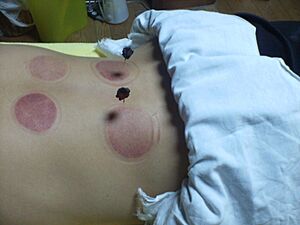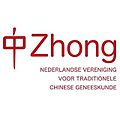Traditional Chinese medicine facts for kids
Traditional Chinese medicine (TCM) is a type of traditional medicine that comes from China. It has been around for at least 3,500 years.
TCM uses different ways to help people feel better. These include herbal medicine (using plants), acupuncture (using thin needles), cupping (using cups to create suction), massage, and exercise. The ideas behind TCM are different from Western medicine. Because of these differences, it can be hard to compare how well TCM works using Western scientific methods.
Many important ideas in TCM come from the teachings of Daoism.
Contents
Understanding Traditional Chinese Medicine
TCM believes that health depends on balancing certain things in your body.
The Five Elements
In TCM, it's important to balance the five elements inside a person. These elements are:
- Wood
- Fire
- Earth
- Metal
- Water
Each of these elements is linked to different parts of your body and different feelings.
Yin and Yang
Each element also has something called yin and yang. These are two opposite but connected parts that need to be in balance. For example, yin might be coolness and rest, while yang might be warmth and activity. They work together and one should not overpower the other.
What is Qi?
To balance yin and yang, TCM focuses on strengthening qi. Qi (pronounced "chee") is seen as an invisible energy or life force. It flows through your body and helps keep everything balanced. When your qi is strong and flows well, your yin and yang are in harmony. This helps you stay healthy.
Each organ in your body is connected to one of the five elements. Balancing the yin and yang of your organs through strong qi is important for good health. The different treatments in TCM aim to bring balance to these elements and energy in your body.
TCM Treatments
TCM uses several methods to help balance the body and improve qi.
Herbal Medicine
This involves using different parts of plants, such as roots, leaves, and flowers. These are often combined into special mixtures.
Acupuncture
Acupuncture uses very thin needles. These needles are gently placed into specific points on the body. The goal is to help qi flow better and relieve pain or other problems.
Cupping
Cupping involves placing special cups on the skin. A vacuum is created inside the cup, which pulls the skin up. This is thought to help with blood flow and energy.
Massage (Tui Na)
Tui Na is a type of Chinese massage. It uses hand techniques to push, rub, and knead the body. This helps to move qi and blood.
Exercise
Exercises like Tai chi and Qigong are also part of TCM. These gentle movements and breathing exercises help to improve the flow of qi and keep the body flexible.
Images for kids
-
The Compendium of Materia Medica is a pharmaceutical text written by Li Shizhen (1518–1593 CE) during the Ming dynasty of China. This edition was published in 1593.
-
Acupuncture chart from the Ming dynasty (c. 1368–1644)
-
Assorted dried plant and animal parts used in traditional Chinese medicines, clockwise from top left corner: dried Lingzhi (lit. "spirit mushrooms"), ginseng, Luo Han Guo, turtle shell underbelly (plastron), and dried curled snakes.
-
Artemisia annua is traditionally used to treat fever. It has been found to have antimalarial properties.
See also
 In Spanish: Medicina china tradicional para niños
In Spanish: Medicina china tradicional para niños











